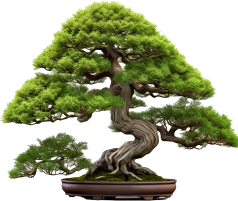Description
DESCRIPTION: legendary trees of tropical Asia, where it is a huge shade tree with long, hanging aerial roots. In tropical rainforests, a layer of wax protects the leaves from drying out in the hot sun. Young plants must be satisfied with modest light that penetrates all the way to the ground. Therefore, even indoor plants need less light. All types of small-leaved ficus are very suitable for shaping bonsai, because they quickly form a strong trunk with finely branching branches and evergreen leaves. The size of the leaves predetermines them for medium and larger bonsai. They are very resistant to hot, dry air, and are therefore the best plants for indoor bonsai.
LOCATION: Ficuses, like other plants, need plenty of light to grow new small leaves. Of the plants used for indoor bonsai, ficuses need the least light. Therefore, they can be placed the farthest from the window. In winter, they require temperatures above 15oC and, with proper watering, they tolerate dry and warm air well. They like their roots dry and warm, they dislike cold drafts during prolonged ventilation and window leaks near the windowsill, which can overcool the pot and soil in winter.
WATERING: abundantly after the soil dries out with soft water. Ficuses react with chlorosis when given a high dose of lime. The water in the pot should not be left in the pot for longer than 1 hour. Watering with warm water of 40oC (bathing water temperature) stimulates growth. The frequency and amount of watering depends, among other things, on the type of ficus.
FERTILIZATION: year-round, every two weeks, with liquid fertilizers.
TRANSPLANTATION: every other year in spring, cut the roots at the same time
SOIL: Bonsai Master bonsai substrate, airy nutrient soil or clay, peat and sand in a ratio of 1:2:2.
PRUNING: if we want to maintain the size of the crown of the ficus, we cut it 3 leaves deeper than the final crown outline. To make this intervention not visible, we cut more often and a smaller number of branches. If we do not want to lose sprouting, we leave a piece of branch behind the last leaf. We prevent the outflow of milky juice by misting with cold water. In winter, we remove large leaves. In summer, we can adjust an overgrown crown by radical shortening with leaf removal.
SHAPING: we can wire at any time, but only for 3 months. We must remove the wire in time, because the branches and trunk grow quickly.
 All in stock - no illustration photos
All in stock - no illustration photos
 Delivery within 48 hours
Delivery within 48 hours
 Over 30 years of experience!
Over 30 years of experience!
